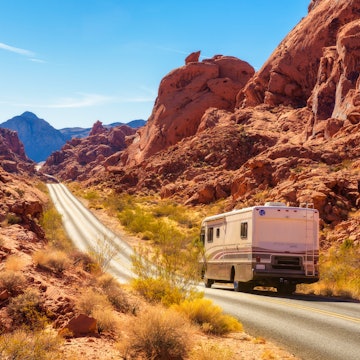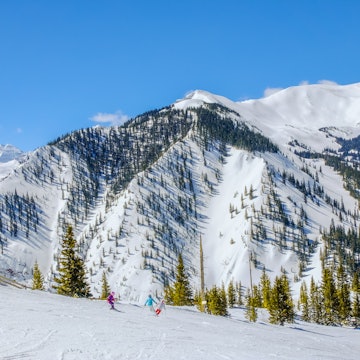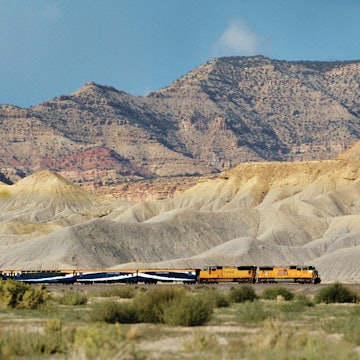
The 11 best places to see dinosaur and plant fossils in the US

Jan 10, 2025 • 8 min read

Dinosaurs at Badlands National Park © Lindsay Guido / Getty Images
Dinosaurs and other ancient plants and animals inspire fascination, even though it might seem like we can only see them in movies like Jurassic Park. But did you know fossils are everywhere in North America? The US is covered in fossil sites featuring ancient critters, big and small. Some are found in deserts that were once ocean floors, others in busy cities where continents shifted millions of years ago.
Whether you've got fossil-obsessed kids at home or are a science geek yourself, here are some of the best places in the US to see fossils and investigate the prehistoric past firsthand.

1. Dinosaur National Monument, Utah
Located just across the Colorado border in Utah's Unita Mountains, Dinosaur National Monument is considered one of the country's most well-known fossil hot-spots. Here, dinosaurs like the Stegosaurus, Allosaurus, and Apatosaurus are embedded in rock at the Carnegie Quarry. If you head out to McKee Springs, you’ll find petroglyphs created by the Fremont indigenous group over 1,000 years ago, the ancestors of the Ute and Shoshone people who live in the area now.
While the monument is a great place to learn about paleontology and see fossils in their natural state, fossil hunting and collecting are strictly prohibited throughout the park, including backcountry areas. This rule ensures the preservation of fossils for scientific research and public education.
Where to camp nearby
There are six campgrounds in Dinosaur National Monument itself, but if you prefer a turnkey glamping site with a tent already set up, head to nearby Vernal, Utah to camp in Steinaker State Park or Red Fleet State Park.

2. Agate Fossil Beds National Monument, Nebraska
While dinosaurs may get all the glory, mammals take the stage at Agate Fossil Beds. The fossils here are about 20 million years old and include creatures such as the Moropus (part donkey, part anteater), the Dinohyus (a boar as big as a bison) and the Beardog (wolf and hyena-like). Walk the Fossil Hills Trail to see the quarries where some of the monument’s most important fossils were found in the early 1900s. Or hop onto the Daemonelix Trail to see the “corkscrew” homes of ancient dry-land beavers, the Palaeocastor.
Please note fossil hunting and collecting are not allowed anywhere within the monument, as all fossils are protected by federal law to preserve the area's scientific and educational value.
Where to camp nearby
There's no camping at Agate Fossil Beds National Monument, but you can find sites at Toadstool Geologic Park – where you can continue to learn about ancient fossils.
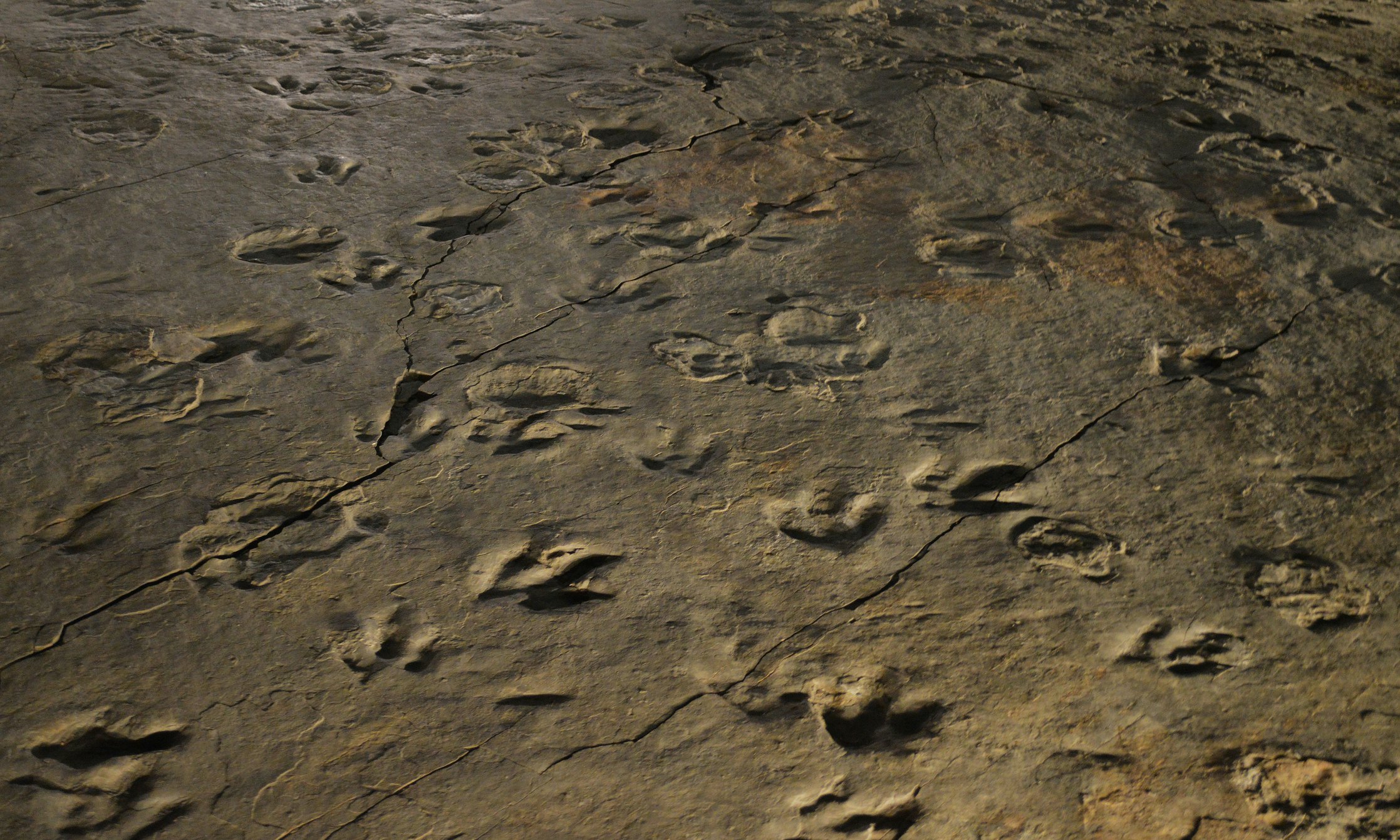
3. Dinosaur State Park, Connecticut
Dinosaur State Park is one of the largest dinosaur track sites on the continent. It is home to 2,000 dinosaur tracks made during the Jurassic period, 500 of which are housed in the Exhibit Center, a large dome at the park's center. You can also explore trails outside with volcanic rock and plant life from the dinosaur era. In summer, buy a “mining rough” bag to pan for fossils and minerals, and staff can help you identify your finds. However, fossil hunting and removing any natural specimens outside of this are strictly prohibited within the park.
Where to stay nearby
There's no camping in Dinosaur State Park, just a day-use picnic pavilion. But you can find nearby vacation rentals, which makes this a great choice for those who prefer an indoorsy vibe.

4. Florissant Fossil Beds National Monument, Colorado
Since studies began in the 1800s at Florissant, scientists have discovered fossils of plants, insects and ancient tree stumps. Research projects are ongoing, so if you’ve ever wanted to visit a working fossil site, Florissant is about as close as you can get. Fossil enthusiasts can walk the trails to see petrified tree stumps and learn about the volcanic activity that shaped the land millions of years ago.
The site offers visitors the chance to view remarkable fossil specimens in the visitor center and on designated trails. Digging for and collecting of any natural or cultural feature is strictly prohibited at Florissant Fossil Beds National Monument. Fossils, rocks, flowers, pine cones, artifacts, etc. must remain here. There are fossil shops and a private quarry outside the monument for visitors wishing for a fossil of their own.
Where to camp nearby
There's no camping in Florissant Fossil Beds National Monument, but you can find sites in Mueller State Park or Pike National Forest. A little further away is 100 Mile Overlook at 105 West Ranch, a private site where the tent is already set up with glamping amenities.
5. Big Brook Preserve, New Jersey
Big Brook Preserve is a great spot for finding Cretaceous-era shark teeth and fossils from when the ocean covered the area. Besides shark teeth, scientists have discovered bones and teeth from Mosasaurs (giant marine reptiles), Plesiosaurs (the inspiration for the Loch Ness Monster) and giant crocodiles. You can hunt for fossils along the creek beds, but remember the rules: only keep what would fit into a 12-ounce can or sandwich-size zip-lock baggie per day, don’t dig into the stream bank and hand tools up to 14 inches may be used.
It’s important to note that fossil collecting is prohibited in certain protected areas within the preserve. Visitors must be mindful of guidelines and stick to designated areas where collecting is allowed.
Where to stay nearby
Like Dinosaur State Park in Connecticut, there's no camping near Big Brook Preserve – this isn't the rural corner of Jersey. That said, there's a bevy of great hotels in nearby Middletown like Oyster Point, a boutique spot with marina views.
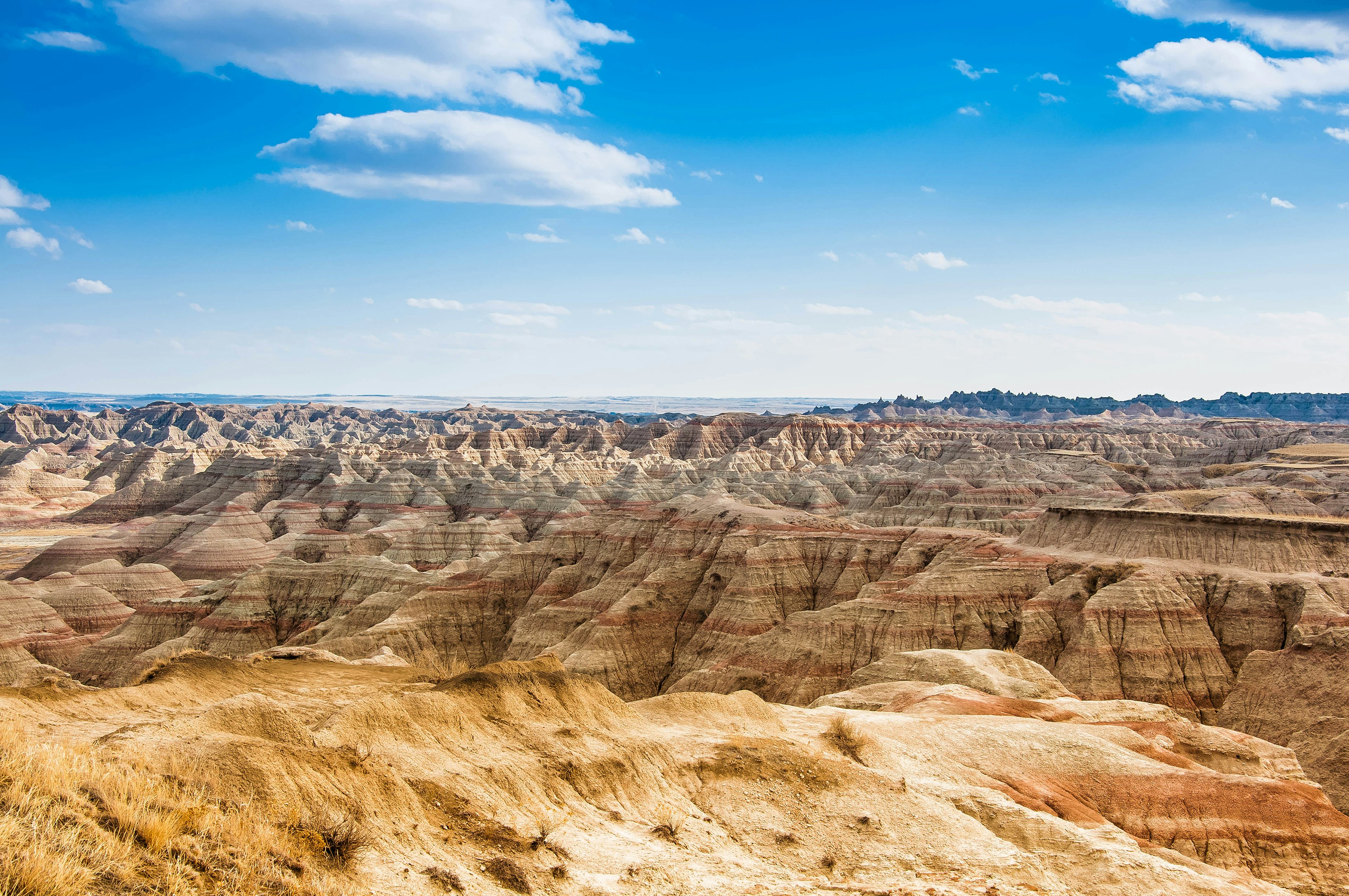
6. Badlands National Park, South Dakota
The dramatic rock formations of Badlands National Park hold ancient animals of all kinds and have worn away enough for us to take a peek. The Oreodont (a bit like a capybara-donkey hybrid), the Nimvarid (known as false saber-toothed cats) and the Brontothere (ancient rhinoceri) all roamed these lands.
The visitor center features a Fossil Preparation Lab that you can visit seven days a week from 9:00am to 4:30pm from the second week in June to the third week in September. You can also hike, enjoy scenic drives and stargaze in the park.
Fossil hunting is strictly prohibited within the park, and removing any natural artifacts is illegal. This protection ensures the preservation of fossils for scientific study and public enjoyment.
Where to camp nearby
There is plenty of camping in Badlands National Park, but if you want to go further afield, Plenty Star Ranch is near Wind Cave National Park in Custer, South Dakota – giving you a two-for-one punch on parks.
7. Montour Preserve, Pennsylvania
The Montour Preserve Fossil Pit is known for its fossil pit, featuring a huge concentration of fossilized brachiopods, gastropods, trilobites and more. Visitors are advised to bring basic tools – a small hammer, safety goggles and a brush. Visit early in the morning before the rocks heat up in the afternoon sun. Note that fossil collecting is only allowed in the fossil pit itself.
Where to camp nearby
Camping isn't allowed at Mountour Preserve, which is managed by the Pennsylvania Game Commission. But nearby Barakah Heritage Farm offers backcountry camping if you bring your own gear – though a tent is available to rent if this is a one-time foray. It also offers the chance to turn your Montour Preserve visit into a broader educational experience with a hands-on farm stay optional add-on.
8. Caesar Creek State Park, Ohio
Caesar Creek State Park, near Waynesville, Ohio, is great for finding fossils. Visitors can dig in special areas to uncover fossils from ancient sea creatures that lived 450 million years ago during the Ordovician period. Keep an eye out for fossils of trilobites, brachiopods and horn corals in the rock. You don’t need any tools – just look around the limestone areas for these ancient finds! In order to collect fossils at Caesar Creek State Park you must first obtain a permit from Army Corps of Engineers Visitor Center by calling (513) 897-1050.
Where to camp nearby
Reservations at the Caesar Creek State Park Campground can be made up to six months in advance. The campground has electric and full hookup sites available.
9. Mineral Wells Fossil Park, Texas
Just an hour from Fort Worth, Mineral Wells Fossil Park is a little-known place where you can find fossils from the Pennsylvanian Period, over 300 million years ago. Visitors can discover crinoids, shark teeth and coral fossils for free here. It’s a perfect spot for anyone who wants a hands-on fossil hunt without large crowds. While the park is open to fossil collecting, it is only allowed in designated areas, on the surface, and with small gardening tools.
Where to camp nearby
Lake Mineral Wells State Park & Trailway has campsites and screened shelters available.
10. Sharktooth Hill, California
Near Bakersfield, Sharktooth Hill is part of an area managed by the Buena Vista Museum of Natural History and is a great place for fossil hunting in California. This site, dating back to the Miocene Epoch about 15 million years ago, has many fossilized shark teeth, whale bones and sometimes even dolphin skeletons. Guided digs let you explore these ancient treasures with expert help. Reservations are required.
Note that fossil collecting is strictly prohibited in some regions of the site as it is a protected location. Visitors must stay within the designated collecting zones or join guided tours that provide access to approved fossil-hunting areas.
Where to camp nearby
While there is no camping available on site, the Kern River Campground is 12 minutes away and has 25 campsites across two sections available.
11. Aurora Fossil Museum, North Carolina
The Aurora Fossil Museum is located in North Carolina and has a Florida fossil site near the Peace River. Across from the museum, visitors can search the fossiliferous pits for fossils from the Miocene period, all donated by the neighboring Nutrien Phosphate plant. Fossil hunting is only available in the pits, where remains of ancient sharks, whales, bony fish, and coral can be found.
Where to stay nearby
While there are not many hotels by the museum, nearby Phoenix Farms Vineyard offers guest suites, RV/Camper stays and tent camping. You can also find hotels in the nearby towns of Washington and New Bern.
You may also like:
Traversing Bears Ears: adventuring through a sacred land
Find your green getaway at these overlooked US national forests
Why Navarre Beach is one of Florida’s best-kept secrets for eco-adventures







